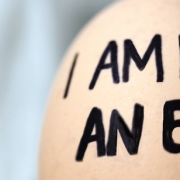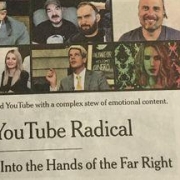Yesterday’s Poetic Justice Warrior Society portrait by Mark Shupe featured Heather Mac Donald. Here is a good example of her unflinchingly sharp analysis of the current identity politics wars.
——————————————————————————————————————————————————
The lawsuit challenging Harvard University’s use of racial preferences in admissions is about “white supremacy,” according to the school’s supporters. So, too, was the defense of U.S. Supreme Court nominee Brett Kavanaugh against the charge of sexual assault, according to Kavanaugh’s critics. Never mind that the plaintiffs in the Harvard lawsuit are Asian-American students who were denied admission to the school despite academic qualifications superior to those of whites, and that Kavanaugh’s accuser was white herself. The roiling mass of resentments and one-upmanship that is identity politics is becoming ever more irrational in the Trump era. Whether a crack-up is imminent remains to be seen.
Harvard caps the number of Asians it admits, allege the plaintiffs—a coalition of Asian-American groups called Students for Fair Admissions—in the lawsuit against the university. As a result, Asian applicants must present higher academic qualifications than any other racial or ethnic group in order to be considered for admission. According to Harvard’s own data, test scores and a high school GPA that would give an Asian-American high school senior only a 25 percent chance of admission would provide a virtual admissions guarantee—95 percent—for an otherwise identical black applicant, a 77 percent chance of admission for a Hispanic student, and a 36 percent chance of admission for a white student. Asians would make up more than 50 percent of the admitted class if Harvard were colorblind, estimates Students for Fair Admissions, instead of the 18.6 percent Asian average maintained over recent years. The white student population would go down from 43 percent to 38 percent. Asians account for 6 percent of the national population; whites, 61 percent.
The Students for Fair Admissions lawsuit, in other words, seeks fairness for Asian-Americans, so that they can be rewarded, rather than penalized, for their academic accomplishments. Whites would lose out under a colorblind system. Yet Harvard’s defenders, including some Asian Harvard students, claim that the suit is really about shoring up white privilege. At a Defend Diversity rally held in Cambridge the day before the lawsuit began, demonstrators held signs reading “Asians Will Not Be Tools for Your White Supremacy.” A Harvard undergraduate who will testify for the defense used the identical language during the Defend Diversity rally: “I, along with so many other Asian-Americans, refuse to be tools of white supremacy.” At a pro-racial-preferences panel held at Harvard a week before the trial, the executive director of Boston’s Asian-American Resource Workshop argued that the “model minority myth is a creation of white supremacy.” An op-ed in the Harvard Crimson addressed to “fellow Asian-Americans” blamed the “structures of white supremacy” for portraying Asians as “smart and hardworking.”
Actually, the portrayal of Asian-Americans as smart and hard-working is based on facts: their academic work ethic, cultivated in the home from childhood, is unmatched by any other racial or ethnic group, including Jews, leading to superior educational and extracurricular achievements, like proficiency in both piano and violin.
The core premise of academic victimology is that whites game the system to disable non-whites. The effort seems to have failed miserably. But rather than acknowledging the implications of Asian success for the narrative of systemic pro-white bias, the proponents of identity politics simply trot out the “white supremacy” mantra as if doing so routs any countervailing evidence. That some left-wing Asians adopt the same rhetoric is a testament to the status accorded to alleged victims of white privilege and to the lure of oppositional identity politics in elite circles.
The use of “white supremacy” to characterize the Harvard racial-preferences lawsuit is a model of lucidity, however, compared with its deployment in the final days of Brett Kavanaugh’s confirmation process. Categories of privilege and oppression shifted, recombined, and split apart, highlighting internecine tensions within the intersectional Left.
The eleventh-hour ambush of Kavanaugh began as a straightforward feminist morality play: male abuser, female victim, each standing in for half of the population. But race and ethnicity trump sex in the victim sweepstakes, so the “white” epithet was soon added to the mix, directed both at Kavanaugh and at the “white male” Republicans of the Senate Judiciary Committee who would be voting on whether to send the nomination to the full Senate. (Texas Republican Ted Cruz became an honorary white for these purposes.) But how could this be “about” race when Kavanaugh’s main accuser, Christine Blasey Ford, was also white? That question was never answered. Instead, the media granted Ford absolution from her whiteness, leaving her simply as the embodiment of female “survivors,” whereas Kavanaugh was portrayed as evil whiteness incarnate.
The same double standard was at work with the “privilege” trope. “There’s something about these privileged, the chosen, the white men in their little clusters who are going to have this glorious life of a Supreme Court justice,” a female Dartmouth graduate told the Chronicle of Higher Education. New York Times columnist Michele Goldberg called Kavanaugh’s Jesuit high school, Georgetown Prep, a “bastion of heedless male entitlement.” A Times news article opined that “few Americans qualify as more privileged and elite than Judge Kavanaugh, a prep school graduate with two Yale degrees.”
But Christine Blasey Ford was as privileged as Kavanaugh. Her tony private high school, Holton-Arms, sits on 57 acres of forested land in suburban Maryland and boasts athletic and performing arts facilities the equal of many a college; it is the girls’ equivalent of Georgetown Prep. Yearbooks from Ford’s era at the school portray a drunken, promiscuous party scene reminiscent of many a male frat. Democrats and the activists chose to ignore those details, while Kavanaugh was triply marked for infamy. For the moment, femaleness, represented by Ford, was a totalizing category, unriven by divisions of color and privilege.
The association of whiteness and sexual assault was on shaky empirical ground, however. From 2005 to 2010, black males committed sexual assault at 3.5 times the rate of white males, according to the federal National Crime Victimization Survey, with most Hispanics being classified as white. Were Hispanics to be removed from the white category, the black-white differential in sexual assault would undoubtedly rise, given the prevalence of domestic violence among Hispanics. Nevertheless, we were to believe that sexual assault was virtually synonymous with whiteness.
The privileged white-male meme reached a fever pitch of intensity after Ford and Kavanaugh’s testimony to the Senate Judiciary Committee. Everything about Kavanaugh’s testimony was attributed to those three attributes, whereas whiteness and privilege had nothing to do with Ford’s testimony. The possibility that Kavanaugh’s remarks had been a reflection of reality, rather than his whiteness or male privilege, was beyond consideration. Kavanaugh had put on the “ultimate display of white entitlement,” according to MSNBC. Jared Bernstein, a former economic advisor in the Obama administration, wrote in the Washington Post that while Ford was “calm, credible and forthright,” Kavanaugh was a “towering inferno of privileged, white, male rage.” (Bernstein presumably knows something about privileged white maleness, having spent his high school years in the virtually all-white, affluent town of Ridgefield, in affluent Fairfield County, Connecticut.) Bernstein reminds us, lest we had forgotten, that the Senate Judiciary Republicans were all “white men,” which is why Kavanaugh’s anger “made sense” to them, he argued.
New York Times columnist Paul Krugman took a similarly deterministic line. Race, sex, and class drove Kavanaugh’s testimony—but not Ford’s. Kavanaugh’s rage resulted from his recognition that an “increasingly diverse society no longer accepts the God-given right of white males from the right families to run things.” Kavanaugh’s belief in his innocence had nothing to do with his remarks.
Portraying Kavanaugh’s testimony as a mere epiphenomenon of his identity-politics-defined traits absolved the anti-Kavanaugh lobby from evaluating the evidence. Just as female self-described “survivors” deserve unquestioned belief, so do privileged white male defendants deserve unquestioned condemnation. The absence of any corroboration for Ford’s story went unmentioned in most mainstream media accounts.
When Maine senator Susan Collins delivered a careful analysis of Ford’s account and explained her reasoning in confirming Kavanaugh to the Supreme Court, however, the identity coalition cleaved. Femaleness was no longer a unifying victim category. Whiteness and privilege were reintroduced into the female side of the ledger, distinguishing Ford’s female backers, still unmarked by race and class, from the turncoats who supported Kavanaugh. These “gender traitors” put “their racial privilege ahead of their second-class gender status,” wrote Alexis Grenell, a gender commentator, in the New York Times. The female senators who voted for Kavanaugh and the female voters who supported Trump did so “to prop up their whiteness,” according to Grenell. Reasons beyond gender and race could have nothing to do with that support, in the eyes of the Left.
Ordinarily, sexual equipment should determine female thinking. Grenell’s “stupid uterus” had held out an “insane hope of solidarity” before the Kavanaugh vote, she says. But now, race had riven feminist solidarity, as it had before the Kavanaugh testimony. The 2017 Women’s March against Donald Trump, for example, had faced criticism for being too white. “I’ve never felt anything remotely resembling sisterhood with white women,” wrote cultural critic Jamilah Lemieux, to explain her absence from the march. Just a month before the Kavanaugh accusations exploded onto the political landscape, Harper’s Bazaar ran an article on how feminism is “white supremacy in heels.” (For the record, I debated its author, Rachel Cargle, for an Economist panel on free speech this September.) White women “completely vacuum the energy, direction, and point of the conversation to themselves and their feelings” whenever black women want to talk about race, Cargle complained. Ouch!
But these divisions were papered over when a privileged white female offered the last hope for keeping a qualified conservative jurist off the Supreme Court—until, that is, Susan Collins “doubled down on white supremacy,” in the words of person-of-color Tamika Mallory, a last-minute addition to the otherwise too-white organizing roster of the 2017 Women’s March. Suddenly, with Collins’s defection, intersectionality was back. White women have failed people of color over and over again, Mallory wrote in the Huffington Post.
Identity-politics tribalism denies the role of reason and ideas in forming individuals’ world views; instead, gonads and melanin reign supreme. The Victorians, too, believed that female thought processes were determined by female hormones; judging by this latest episode, the Victorians may have been on to something. Grenell complained in the Times about Senator Collins’s “slow funeral dirge about due process and some other nonsense,” irrelevancies that Grenell “couldn’t even hear” through her “rage headache.” All those picayune details about burdens of proof and evidentiary coherence are simply migraine-producing male hang-ups that interfere with uterine solidarity. Eve Ensler, author of the feminist theatrical gripe fest The Vagina Monologues, urged female voters to support Ford because “violence against women destroys our souls.” (Ensler has reemerged from the cis-gender doghouse to which she had been relegated for her use of the V-word, an anti-trans macroaggression, if you’re keeping score at home.) But the allegedly soul-destroying effects of sexual assault have nothing to do with whether Ford’s story added up; that latter judgment was case-specific and required a careful sifting of allegations and known facts. Feminism, however, already knows who is credible and who not, based on group identity.
The Harvard racial-preferences lawsuit, like the now-concluded battle over the Kavanaugh nomination, has nothing to do with “white supremacy.” The Left’s increasingly desperate approach to political debate may energize its base, but unmoors it from reality. Sooner or later, that unreality could be its downfall.












